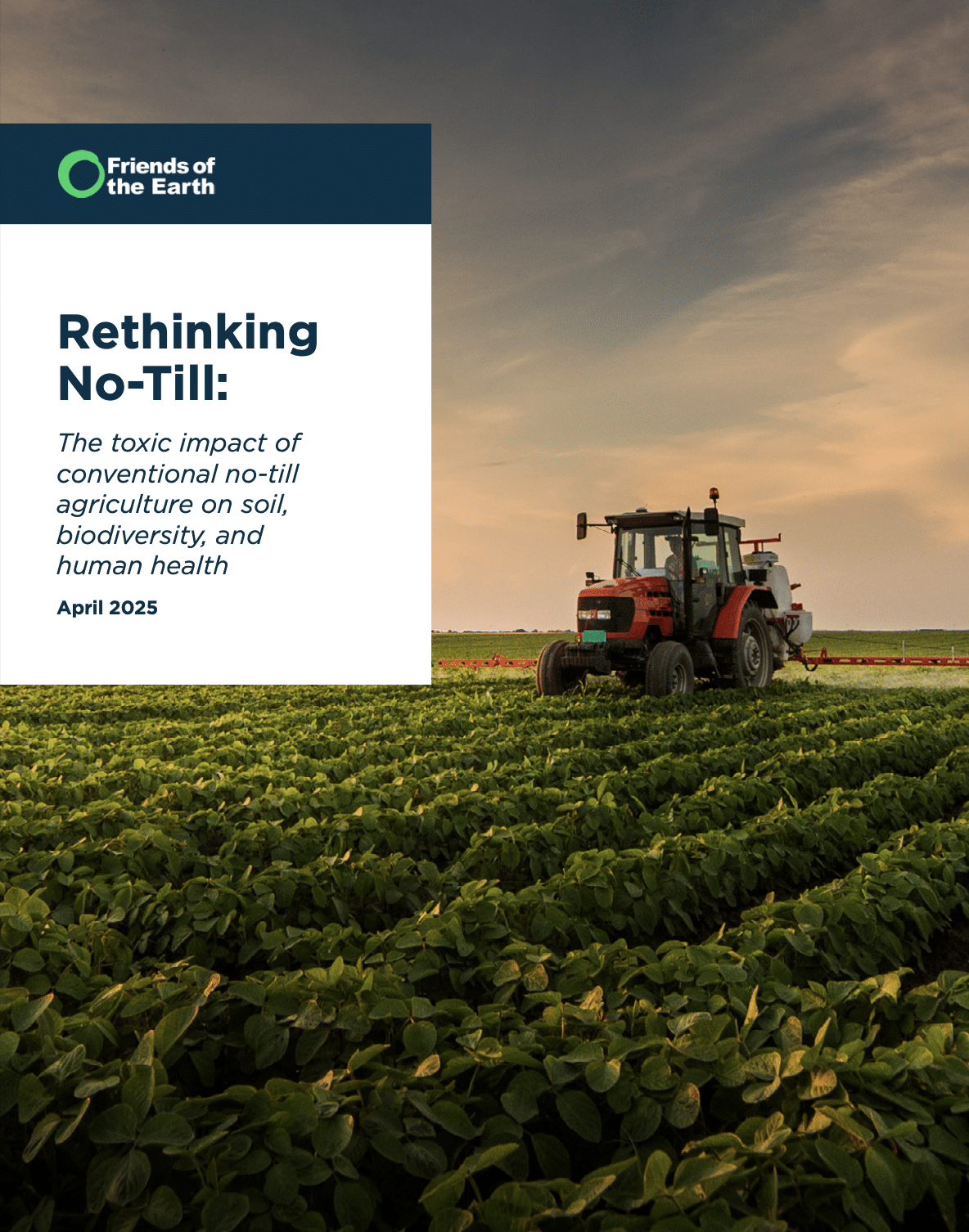Rethinking No-Till

The Toxic Impact of Conventional No-Till Agriculture on Soil, Biodiversity, and Human Health
With billions of dollars being invested, and the future of our food system at stake, we must ensure that regenerative agriculture is guarded against false marketing claims and pesticide industry greenwashing.
No-till — a farming practice that dramatically reduces tillage and plowing — is widely lifted up as a leading form of regenerative agriculture. But Rethinking No-Till finds that most conventional no-till falls far short of the goals of regenerative agriculture, which include building soil health, protecting biodiversity, and supporting human wellbeing.
The fact that so many farmers have adopted no-till practices is evidence that they are interested in protecting their soil. We must restructure the public policies and market signals that lock in chemical-intensive agriculture in the U.S. to support these and other farmers to achieve truly regenerative agriculture.
Read the press release
Read the executive summary
Read the full report
Toxic pesticides that harm soil and human health are the foundation of most conventional no-till
Based on a first-of-its-kind analysis of U.S. Department of Agriculture (USDA) data, the report finds that most no-till systems are so heavily dependent on herbicides to manage weeds that a staggering one-third of total annual pesticide use (a term that includes herbicides, insecticides, and fungicides) in the U.S. can be attributed to no-till* corn and soy production alone. This chemical use has devastating consequences for soil life, human health, biodiversity, and the climate.
While no-till farming can be done without harmful chemicals, the report finds that, for the top two no-till crops, corn and soy, the vast majority of acreage (93%) uses toxic herbicides that are linked to cancer, birth defects, infertility, neurotoxicity, disruption of the gut microbiome, endocrine disruption, and other serious human health impacts. These chemicals are being broadcast across nearly 100 million acres nationwide, predominantly in the American Heartland and Great Plains. Glyphosate, the cancer-linked main ingredient in the widely criticized weedkiller Roundup, is the most widely used herbicide in no-till corn and soy.
No-till typically increases herbicide use in conventional farming systems, and at least 90% of no-till corn and soy acres rely on seeds genetically engineered to withstand herbicides, further driving a cycle of increased herbicide use. On top of this, no-till corn seeds are almost always coated with neonicotinoid insecticides.
These chemicals are destroying the soil that grows our food and are decimating pollinators, which are essential to food production and healthy ecosystems. They harm the soil microbiome and invertebrates like worms and beetles that are central to building healthy soils that can sequester carbon, conserve water, and enhance farmers’ resilience to droughts and floods.
Conventional no-till is not a climate solution
The report debunks the faulty assumption that no-till increases stores of carbon in the soil, summarizing extensive scientific research showing there is no clear relationship between no-till and soil carbon sequestration.
Conventional no-till is also heavily dependent on fossil-fuel chemicals in the form of herbicides and synthetic fertilizers. The greenhouse gas emissions associated with these fossil-fuel-based inputs in no-till corn and soy are equivalent to that of 11.4 million cars on the road over an entire year — about the number of cars in the top nine no-till states combined.
Chemical farming is not regenerative
Large-scale, chemical-intensive agriculture currently predominates in the U.S. not through the fault of farmers, but because that is what public policies and markets support. Chemical companies are deeply intertwined with no-till’s ascendance because it increases the market for their toxic products. “Let paraquat be your plow,” reads a 1972 advertisement placed by Chevron in the magazine No-Till Farmer. Now, pesticide companies are capitalizing on the growing interest in soil health by claiming conventional no-till is “regenerative.” But chemical farming is not regenerative — broadcasting toxic pesticides and overapplying synthetic fertilizers is incompatible with building soil health, human health, and ecosystem health.
Truly regenerative agriculture is holistic and can include tillage
A narrow focus on single practices like tillage is misleading — truly regenerative agriculture works with the farming system as a whole. Research shows that careful tillage in holistic farming systems can achieve better soil outcomes than chemical-intensive no-till systems.
A dramatic reduction of agrochemicals that harm soil and human health must be a central tenet of all regenerative agriculture initiatives. Policymakers and companies need to invest in leading forms of regenerative agriculture like diversified organic farming and provide conventional farmers the support they need to get off the chemical treadmill and truly regenerate the land that feeds us.

Organic is Regenerative
Organic agriculture has the benefit of being enforced through a rigorous legal standard, and decades of research shows that organic can achieve the key aims of regenerative agriculture, including soil health, climate resilience, soil carbon sequestration, reduced emissions, and the protection of biodiversity, human health, and community wellbeing. Organic food is grown without synthetic fertilizers and more than 900 synthetic pesticides allowed in conventional agriculture.
*For corn and soy, the USDA reports data on “no-till or minimum-till” acreage combined in their Chemical Use Survey Highlights. We used this data as the basis of our analysis. We refer to these acres as “no-till” throughout this report for simplicity and to follow the term of art that has shaped the public conversation and billions worth of public and private spending. It is also worthwhile to note that “no-till” is largely a misnomer: USDA data show that at least 80% of “no-till” corn, soybean, wheat, and cotton acres were tilled at some point over a four-year period.
Ways to Support Our Work

Read Latest News
Stay informed and inspired. Read our latest press releases to see how we’re making a difference for the planet.

See Our Impact
See the real wins your support made possible. Read about the campaign wins we’ve fought for and won together.

Donate Today
Help power change. It takes support from environmental champions like you to build a more healthy and just world.